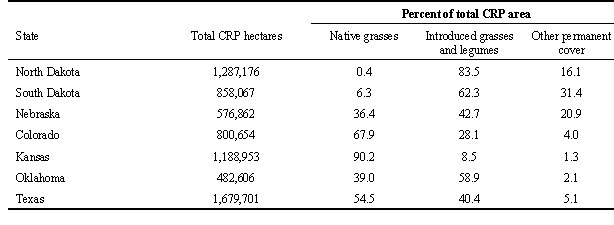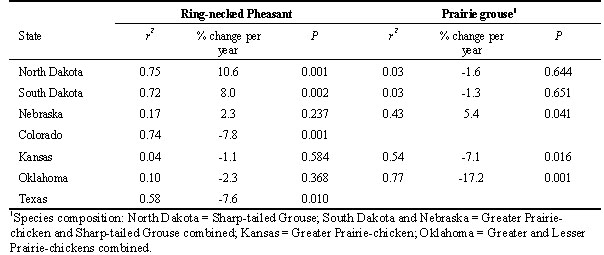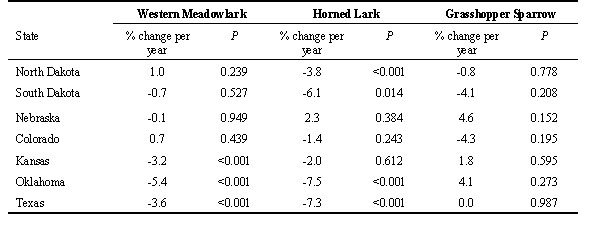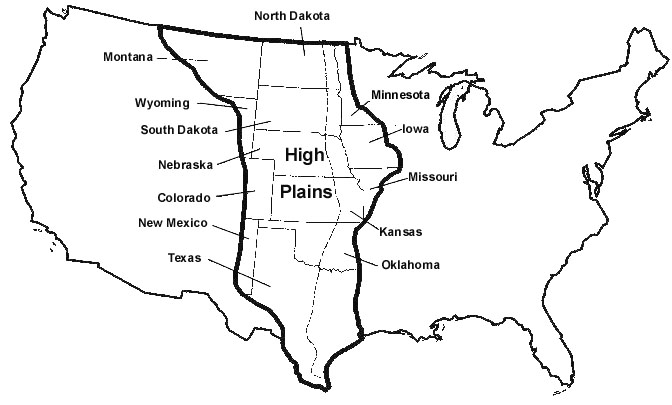
S35.2: United States farm policy and gamebird conservation in the Great Plains: An overview of the Conservation Reserve Program
Kevin E. Church1 & J. Scott Taylor2
1Nebraska Game and Parks Commission, 2200 N. 33rd Street, PO Box 30370, Lincoln, Nebraska 68503-0370, USA, e-mail
kchurch@ngpc.state.ne.us; 2Nebraska Game and Parks Commission, 2200 N. 33rd Street, PO Box 30370, Lincoln, Nebraska 68503-0370, USA, e-mail staylor@ngpc.state.ne.us Church, K.E. & Taylor J.S. 1999. United States farm policy and gamebird conservation in the Great Plains: An overview of the Conservation Reserve Program. In: Adams, N.J. & Slotow, R.H. (eds) Proc. 22 Int. Ornithol. Congr., Durban: 2097-2103. Johannesburg: BirdLife South Africa.Implementation of the Conservation Reserve Program (CRP) of the Food Security Act of 1985 converted >14.7 million ha of highly erodible cropland in the United States to a variety of permanent cover types for >10 years. The greatest proportion (57% or 8.3 million ha) of the CRP lands occurred in the High Plains portion of the Great Plains. This region also hosts diverse and abundant populations of gamebirds and other grassland-dependent wildlife. We examined the relationship between the amount of CRP lands and trends of abundance for gamebirds (Ring-necked Pheasant Phasianus colchicus torquatus, Greater Prairie-chicken Tympanuchus cupido pinnatus, Lesser Prairie-chicken Tympanuchus pallidicinctus, Plains Sharp-tailed Grouse Tympanuchus phasianellus jamesi) and passerines (Western Meadowlark Sturnella neglecta, Horned Lark Eremophila alpestris, and Grasshopper Sparrow Ammodramus savannarum) in the High Plains from 1986 to 1995. Our results do not support the hypothesis that the CRP generally benefited grassland bird populations. We attribute this primarily to an incomplete understanding by authors of the original legislation of the factors limiting birds in the High Plains; and secondarily to the inability to implement a national farm programme that was flexible enough to address limiting factors operating at a state or regional scale. Last, we observed that native upland gamebirds such as prairie grouse may be responding to large-scale environmental conditions similarly to other sympatric breeding birds, thus providing a potentially valuable indicator of bird-habitat interactions in the High Plains.
INTRODUCTION
The enormous effect of agriculture on wildlife, particularly gamebirds, has long been recognised (Stoddard 1931, Leopold 1933:274), and strongly influenced by governmental agricultural policies and programmes (Berner 1988, Brady & Hamilton 1988). Although many national programmes in the United States of America have had detrimental effects on wildlife, some that encouraged establishment of grassland cover on large blocks of idled cropland had significant beneficial effects (Berner 1988).
In the early 1980s, conservationists began organising an effort to integrate more wildlife-friendly provisions into national agriculture programmes, which were scheduled for revision in 1985. Provisions that benefited grassland-dependent birds were viewed as particularly high priorities, because these species have exhibited more dramatic declines than any other bird group in North America (Knopf 1994) and are sensitive to intensive and extensive agricultural practices (Warner 1994). Because of potential benefits foreseen for grassland-dependent gamebirds, hunter-based non-government organisations were important participants in this political effort. Although agriculture-based interests were most influential in drafting the new national farm programme, environmental groups were successful in persuading the U.S. Congress to include the conservation of natural resources as an explicit goal of the legislation (Brady & Hamilton 1988).
As a result of these efforts, the Conservation Reserve Program (CRP) was established by the Food Security Act of 1985, and was designed to address a declining agricultural economy and growing concern about the effects of farming on the environment. The CRP represented an effective fusion of agricultural and environmental policies that paid farmers (>$1.6 billion US/year) to convert >14.7 million ha of highly erodible cropland in the United States to a variety of permanent cover types for >10 years. The potential benefits of the CRP to farmland wildlife were projected to be substantial (Brady & Hamilton 1988), and because Ring-necked Pheasant Phasianus colchicus torquatus populations responded positively to a similar multi-year set-aside programme in the 1950s and 1960s (Berner 1988), benefits to grassland-dependent gamebirds seemed especially promising.
A substantial proportion (57% or 8.3 million ha) of land enrolled in the CRP occurred in the High Plains portion (i.e. original short- and mixed-grass prairie regions in the states of North Dakota, Montana, South Dakota, Wyoming, Nebraska, Colorado, Kansas, New Mexico, Oklahoma, and Texas) of the Great Plains (Fig. 1). However, although it is generally believed that wildlife in the Great Plains has benefited from the CRP (e.g. Carmichael 1997), empirical evidence of population responses over a large spatial scale in the High Plains is lacking. Therefore, we examined trends in selected bird populations from 1986 to 1995 to determine if the CRP’s potential benefits to upland game and other grassland-nesting birds common in the High Plains were realised. A secondary objective was to determine if monitoring upland gamebird harvest provided an accurate measure of population responses by other grassland-nesting birds in the High Plains.
METHODS
To detect responses of grassland-dependent gamebird populations to the CRP, we examined trends in harvest of selected species during the first ten years (1986 to 1995) of the programme for several states in the High Plains (North Dakota, South Dakota, Nebraska, Colorado, Kansas, Oklahoma, and Texas). Total harvest/year was used as the index of abundance in trend analyses because it was readily available from all states, was nearly always correlated with effort-related abundance indexes (e.g. harvest/hunter/day, harvest/hunter/year) when these were simultaneously available. Furthermore, state game agencies generally view total harvest as a primary measure of success or failure of large-scale management initiatives.
We obtained Ring-necked Pheasant and prairie grouse (Greater Prairie-chicken Tympanuchus cupido pinnatus, Lesser Prairie-chicken Tympanuchus pallidicinctus, and Plains Sharp-tailed Grouse Tympanuchus phasianellus jamesi) harvest data for 1986 to 1995 from each state game agency within the study region. Because of low population sizes, harvest, and precision of harvest estimates, data for Lesser Prairie-chicken were excluded from analyses whenever possible. All states provided pheasant harvest data, North Dakota provided Sharp-tailed Grouse data, Kansas provided Greater Prairie-chicken data, South Dakota and Nebraska provided combined data for Sharp-tailed Grouse and Greater Prairie-chicken, and Oklahoma provided combined data for Greater Prairie-chicken and Lesser Prairie-chicken. Colorado did not permit prairie grouse hunting in the portion of the state within the Great Plains, and Texas had no harvest of prairie grouse.
We used simple linear regression on raw and square root-transformed (to account for potential increases in variances as harvest counts increased) data, and incorporated a first-order autoregression term into linear regression models (to account for potential autocorrelation of these time series data) to obtain harvest trend estimates for each state and species or combination of species. These three methods provided similar results, so we presented results for simple linear regressions performed on the raw data only.
We also examined Breeding Bird Survey (BBS) data (Sauer et al. 1997) during 1986 to 1995 for selected nongame passerines common to the High Plains states we studied (Western Meadowlark Sturnella neglecta, Horned Lark Eremophila alpestris, and Grasshopper Sparrow Ammodramus savannarum) to determine if population trends were consistent among game and nongame birds breeding in similar grassland habitats. The BBS data we used were collected in June along 39.4-km routes with 50 evenly-spaced observation stops on secondary roads throughout the Great Plains (Droege 1990). At each stop, observers counted all birds heard or seen during a 3-minute interval. The total number of each species observed on the route was used as an annual index of abundance. To put trend observations in the context of the CRP attributes within each state, we examined the CRP data summarised by the U.S. Department of Agriculture (1996) (Table 1).
RESULTS
Harvest trends varied by state and species during 1986 to 1995 (Table 2). North Dakota and South Dakota had positive trends in pheasant harvest, whereas Colorado and Texas had negative trends. Prairie grouse harvest in Kansas, Nebraska, and Oklahoma declined, with no state showing an increasing trend. Similarly, none of the three grassland passerines showed an increasing trend in any state, with Western Meadowlark or Horned Lark declining in 5 of 7 states (Table 3).
States with increasing pheasant harvest trends (North Dakota and South Dakota) tended to have a higher proportion of their CRP lands planted to introduced grasses and legumes, whereas states with predominantly native grass CRP fields (e.g. Colorado and Kansas) tended to have stable or declining pheasant harvest trends. No relationship between nongame trends and CRP vegetation type was apparent.
DISCUSSION
Our results did not support the hypothesis that the CRP generally benefited grassland bird populations throughout the High Plains during 1986 to 1995. In particular, apparent positive effects were consistently absent for native prairie grouse and breeding passerines. These findings are consistent with comments by Carmichael (1997) when characterising the effects of the CRP on wildlife in the southeastern U.S. However, it is unknown what population trends would have existed in the High Plains during this period without the CRP (i.e. our observations lacked a control), so the relationships between the CRP grasslands and avian population trends we observed were equivocal.
Based on previous responses to multi-year set-aside programmes (Berner 1988), pheasant were predicted to substantially benefit from the CRP. This hypothetical relationship engendered significant support for the CRP from organizations representing gamebird hunters, and helped shape guidelines by which the programme was implemented (Hays & Farmer 1990). However, despite this influence, our results suggest pheasant populations were significantly enhanced only in North Dakota and South Dakota within the Great Plains states we studied. Although local effects on pheasant habitat use (Delisle & Savidge 1997) and production (Berthelson et al. 1990) were observed elsewhere in the Great Plains, CRP fields apparently did not negate large-scale limiting factors (e.g. agricultural practices or climatic conditions) present in the central and southern portions of the High Plains.
One hypothesis for this latitudinal difference concerns the degree to which nesting cover may limit pheasant populations from north to south in the High Plains. A substantial portion of this region is devoted to production of winter-sown wheat Triticum aestivum. In the southern and central portions of the High Plains, wheat attains sufficient height to provide abundant nesting cover for pheasant (Snyder 1984), whereas slower and later wheat maturation prohibits early use for nesting in the north. The availability of nesting cover is therefore potentially more limiting to populations in the northern Great Plains, and the CRP grassland may have provided a habitat component necessary to allow populations there to increase (George et al. 1979).
Further, winter weather is generally more severe in the north than the south, perhaps making winter cover provided by the CRP fields in the north more valuable to pheasant than it was in warmer southern latitudes. This may have been true regardless of the fact that the CRP fields in the north were primarily composed of introduced grasses and legumes, which are more prone to collapse under heavy snow than warm-season native grasses (George et al. 1979), which were more common in the CRP fields farther south. The grass-legume mixtures may also have provided a relatively insect-rich environment more conducive to pheasant chick foraging than dense stands of native grasses (Burger et al. 1993; R.D. Rodgers, Kansas Department of Wildlife & Parks, unpublished).
In conclusion, although benefiting wildlife was an objective of the original 1985 legislation, to date the CRP has generally not addressed factors limiting grassland-dependent birds at the landscape or population level in the High Plains. We attribute this primarily to an incomplete understanding by authors of the original legislation of the factors limiting birds in the High Plains; and secondarily to the inability to implement a national farm programme that was flexible enough to address limiting factors operating at a state or regional scale. However, despite the general lack of empirical evidence in support of the CRP’s effects on upland gamebirds and breeding passerines in the High Plains, other environmental benefits such as reduced erosion and applications of agrochemicals, as well as positive social aspects like increased recreational access or rural economic affects may serve to justify continuation of the CRP.
Last, we concur with Church et al. (1993) that it appears native upland gamebirds such as prairie grouse may be responding to large-scale environmental conditions similarly to other sympatric breeding birds, thus providing a potentially valuable indicator of bird-habitat interactions in the High Plains. However, it should be noted that this relationship was not consistently observed between pheasant, an exotic gamebird, and other grassland-nesting birds throughout the region.
ACKNOWLEDGEMENTS
We thank Robin M. Little for inviting us to contribute this work at the 'Gamebirds as Keys to Conservation' symposium of the XXI International Ornithological Congress in Durban, South Africa at which Amy L. Richert kindly gave the oral presentation. Financial support for work on pheasant responses to the Conservation Reserve Program in the High Plains was initially provided by American Friends of the Game Conservancy (now Game Conservancy USA), and later by the Federal Aid in Wildlife Restoration Fund, Nebraska Game & Parks Commission, South Dakota Department of Game, Fish & Parks, and Kansas Department of Wildlife & Parks. We also thank Norm Dey, Steve DeMaso, Jerry Kobriger, Markus Peterson, Tom Remington, Steve Riley, and Randy Rodgers for providing gamebird harvest data.
REFERENCES
Berner, A.H. 1988. Federal pheasants - impact of federal agricultural programs on pheasant habitat, 1934-1985. Pages 45-93 In: Hallett, D.L., Edwards, W.R., & Burger, G.V. (eds) Pheasants: symptoms of wildlife problems on agricultural lands. North Central Section of the Wildlife Society, Bloomington, Indiana, USA. 345pp.
Berthelson, P.S., Smith, L.M., & George, R.R. 1990. Ring-necked pheasant nesting ecology and production on CRP lands in the Texas southern High Plains. Transactions of the North American Wildlife and Natural Resources Conference 55:46-56.
Brady, S.J. & Hamilton, R. 1988. Wildlife opportunities within federal agricultural programs. Pages 95-109 In: Hallett, D.L., Edwards, W.R., & Burger, G.V. (eds) Pheasants: symptoms of wildlife problems on agricultural lands. North Central Section of the Wildlife Society, Bloomington, Indiana, USA. 345pp.
Burger, L.W.Jr., Kurzejeski, E.W., Dailey, T.V. & Ryan, M.R. 1993. Relative invertebrate abundance and biomass in Conservation Reserve Program plantings in northern Missouri. Pages 102-108 In: Church, K.E. & Dailey, T.V. (eds) Quail III: national quail symposium. Kansas Department of Wildlife and Parks, Pratt, Kansas, USA.
Carmichael, D.B.Jr. 1997. The Conservation Reserve Program and wildlife habitat in the southeastern United States. Wildlife Society Bulletin 25:773-775.
Church, K.E., Sauer, J.R. & Droege, S. 1993. Population trends of quails in North America. Pages 44-54 In: Church, K.E. & Dailey, T.V. (eds) Quail III: national quail symposium. Kansas Department of Wildlife and Parks, Pratt, Kansas, USA.
Delisle, J.M. & Savidge, J.A. 1997. Avian use and vegetation characteristics of Conservation Reserve Program fields. Journal of Wildlife Management 61:318-325.
Droege, S. 1990. The North American Breeding Bird Survey. Pages 1-4 In: Sauer, J.R. & Droege, S. (eds) Survey designs and statistical methods for the estimation of avian population trends. U.S. Fish and Wildlife Service, Biological Report 90(1).
George, R.R., Farris, A.L., Schwartz, C.C., Humburg, D.D., & Coffey, J.C. 1979. Native prairie grass pastures as nesting cover for upland birds. Wildlife Society Bulletin 7:4-9.
Hays, R.L. & Farmer, A.H. 1990. Effects of the CRP on wildlife habitat: emergency haying in the Midwest and pine plantings in the Southeast. Transactions of the North American Wildlife and Natural Resources Conference 55:30-39.
Knopf, F.L. 1994. Avian assemblages on altered grasslands. Studies in Avian Biology 15:247-257.
Leopold, A. 1933. Game management. Charles Scribner’s Sons, New York, New York, USA. 481pp.
Sauer, J.R., Hines, J.E., Gough, G., Thomas, I., & Peterjohn, B.G. 1997. The North American Breeding Bird Survey results and analysis. Version 96.4. Patuxent Wildlife Research Center, Laurel, Maryland, USA.
Snyder, W.D. 1984. Ring-necked pheasant ecology and wheat farming on the High Plains. Journal of Wildlife Management 48:878-888.
Stoddard, H.L. 1931. The bobwhite quail: its habits, preservation and increase. Charles Scribner’s Sons, New York, New York, USA. 559pp.
U.S. Department of Agriculture. 1996. Agricultural statistics, 1995-96.
Warner, R.E. 1994. Agricultural land use and grassland habitat in Illinois: future shock for midwestern birds? Conservation Biology 8:147-156.
Table 1. Characteristics of Conservation Reserve Program (CRP) lands in selected central Great Plains states (U. S. Department of Agriculture 1996).

Table 2. Trends in harvest of Ring-necked Pheasant and prairie grouse in selected central Great Plains states during 1986 to 1995, based on simple linear regression.

Table 3. Trends in Western Meadowlark, Horned Lark, and Grasshopper Sparrow populations during 1986 to1995 in selected central Great Plains states, based on route regression analyses of Breeding Bird Survey data (Sauer et al. 1997).

Fig. 1. High Plains portion (west of dotted line) of the Great Plains (bold outline) of the United States.
